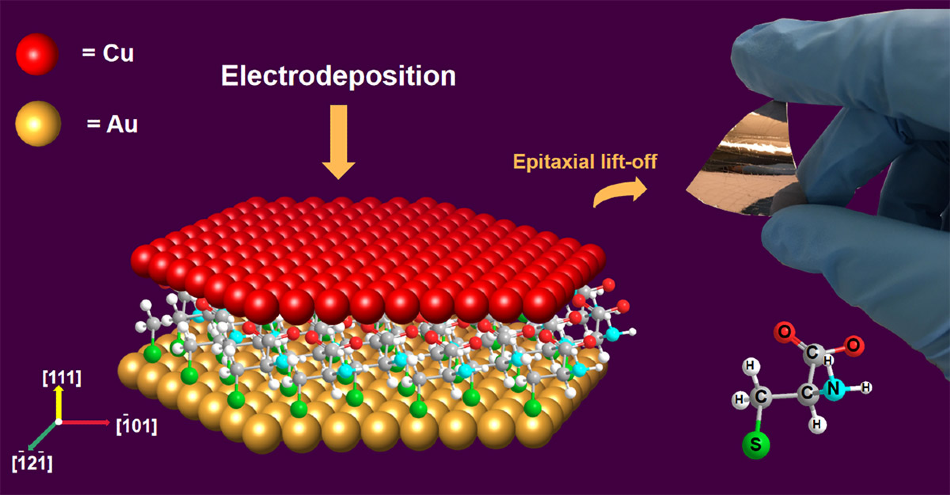Oct 1 2020
Scientists from Missouri University of Science and Technology (Missouri S &T) have demonstrated for the first time that highly ordered copper thin films can be directly crystallized on a one-molecule-thick layer of organic material instead on the inorganic substrates that have been utilized for years.
 Copper thin films are created by electrodeposition of copper, Cu (111), on a self-assembled organic monolayer of the amino acid L-cysteine on gold, Au (111). Image Credit: Bin Luo.
Copper thin films are created by electrodeposition of copper, Cu (111), on a self-assembled organic monolayer of the amino acid L-cysteine on gold, Au (111). Image Credit: Bin Luo.
The copper thin films developed by the team are superior candidates that can be uses as fundamental substances for high-temperature superconductors, LEDs, and solar cells, stated Dr Jay Switzer, Chancellor’s Professor and Curators’ Distinguished Professor emeritus of chemistry. Dr Switzer is also the principal investigator of the study.
He added that while other scientists have earlier electroplated thin films onto self-assembled monolayers (SAMs) of organic molecules, such films did not exhibit the in-plane and out-of-plane order needed for electronic applications.
Like the way seashells, bones or teeth are formed, we’ve found a way to give the copper films the right level of crystalline order and durability for their applications. With our process, which mimics biomineralization, we’re creating inorganic thin films with superior qualities of single-crystal-like order, high conductivity and flexibility.
Dr Jay Switzer, Chancellor’s Professor and Curators’ Distinguished Professor, Emeritus of Chemistry, Missouri University of Science and Technology
During their experiments, the team electrodeposited copper on one layer of L-cysteine—a protein- building amino acid that was positioned on ordered layers of gold on silicon.
Once the copper crystallized into an ordered film, the researchers were able to lift off a single, crystal-like foil by merely using an adhesive tape.
The researchers noted that their process offers a low-cost method to free-standing metal foils with properties mimicking those of costly single crystals.
Dr Switzer stated that the new technique demonstrates the significance of the cysteine molecule in guiding the development of ordered crystalline structures.
As a contribution to science, Dr Switzer pointed out that the technique will facilitate future work on the deposition of ordered films of other significant materials, like catalysts and semiconductors, onto organic self-assembled monolayers.
The latest technique may also help reduce the impacts of lattice mismatch that at times restrict crystalline, or epitaxial, growth.
Other Missouri S&T researchers on the team include Dr Avishek Banik, a post-doctoral researcher in chemistry; Dr Eric Bohannan, a senior research specialist in S&T’s Materials Research Center; and also Bin Luo, a doctoral student in chemistry.
The researchers’ results will be published in the forthcoming issue of the American Chemical Society’s Journal of Physical Chemistry C and are available currently online in the study, titled, “Epitaxial Electrodeposition of Cu (111) onto an L-cysteine Self- assembled Monolayer on Au (111) and Epitaxial Lift-off of Single-crystal-like CuFoils for Flexible Electronics.”
Journal Reference:
Luo, B., et al. (2020) Epitaxial Electrodeposition of Cu (111) onto an l-Cysteine Self-Assembled Monolayer on Au (111) and Epitaxial Lift-Off of Single-Crystal-like Cu Foils for Flexible Electronics. The Journal of Physical Chemistry C. doi.org/10.1021/acs.jpcc.0c05425.